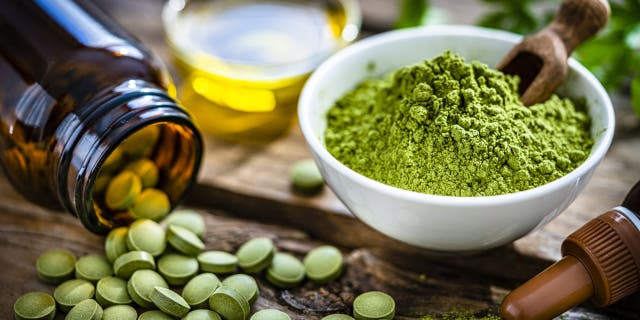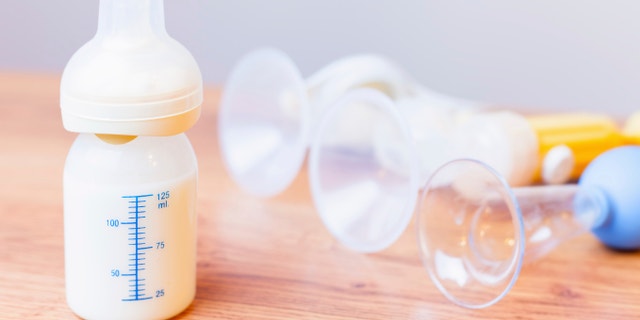Baby formula is the latest staple to be hit by supply chain shortages in the U.S.
parenting” target=”_blank”>Parents< under six months old have taken to social media to share their concerns after seeing barren store shelves.
Behind the scenes, online inquiries on how to “increase breast milk” have become a top search term in 38 states, according to recent data on Google Trends.
In particular, family-and-friends” target=”_blank”>searchers<
Here’s what lactation experts and health care professionals want mothers to know about breast milk production before turning to diet changes or tools.
Foods, drinks and supplements connected to breast milk production
Rachel Taylor, a registered nurse, postpartum and lactation advocate from Birmingham, Alabama, has over 15 years of experience working with postpartum and breastfeeding mothers.
Taylor told Fox News Digital that she mainly recommends lactation cookies, teas, water and a few dietary supplements or ingredients that have demonstrated beneficial results for nursing mothers.
Lactation cookies
Many baby care manufacturers make prepackaged lactation cookies and other snacks for the purpose of increasing milk supply. These functional treats usually “include oats, brewer’s yeast, and flaxseed, all of which are galactogogues – molecules that help maintain and increase milk production,” said Taylor. If you’d prefer to make your own cookies, Taylor recommends using rolled or steel-cut oats and no more than three tablespoons of brewer’s yeast (per day).

Oatmeal cookies are a popular lactation cookie flavor. Retailers often stock these cookies in baby care aisles. Some specialty bakeries also make lactation cookies.
(iStock)
Lactation teas
Manufacturers also produce lactation teas for the purpose of increasing milk supply.
These herbal teas typically “contain fennel and fenugreek,” which have been shown to help breast milk production in research studies, Taylor said. In particular, fenugreek is found in “Mother’s Milk” teas and the clover-like herb has been used by lactating mothers for decades.

Fennel tea is a herbal galactagogue (milk supply producing molecule) that has been used for centuries around the world.
(iStock)
“A 2018 study [in the National Library of Medicine] found that fenugreek users saw a significant increase in milk production,” Taylor told Fox News Digital. “Some women saw an increase within 24 hours and some said it took about two weeks.”
PEDIATRICIAN’S PLEA TO PARENTS: DO NOT MAKE YOUR OWN BABY FORMULA
If a mom wishes to take fenugreek supplements alone, Taylor said they should follow the supplement package directions. The FDA recommends pregnant and nursing women consult their health carea> provider before taking any dietary supplement.<
Moringa can be purchased in powder, capsule and herbal tea form in many drug stores.

Moringa plants come from the drought-resistant moringa tree that’s often found in the Indian subcontinent. It’s used in many dietary supplements for its vitamin C, potassium, calcium and iron content. The plant has been found to increase prolactin.
(iStock)
Torabangun
Another botanical that’s been connected to increased milk supply, but is “difficult to find in the U.S.” is torabangun, which comes from “the mint family,” according to Madden.
She said the “mechanism of action [in torabangun] is proliferation of mammary gland cells.” It can be found in a few laction supplements.

Torabangun is a herb that’s commonly used by nursing mothers in Indonesia. The mint species is rich in vitamins and minerals and has been found to grow mammary gland cells in lactating mothers.
(iStock)
Strategies and tools for increased breast milk production
Routine milk pumping is “the best way to increase supply,” said Jackee Haak, a North Dakota-based registered nurse and board member of the United States Lactation Consultant Association.
“No matter what someone is eating, the most important factor in producing milk is frequent removal of milk,” Haak told Fox News Digital. “Breastfeeding is all supply and demand.”
CLICK HERE TO GET THE FOX NEWS APP
She said breast milk can be removed through feedings, specialized breast pumps or manually with hands.

The CDC says ‘breast milk is the best source of nutrition for most babies’ and it ‘can also help protect you and your baby against some short- and long-term illnesses and diseases.’ However, the health agency notes that formula can be used if a mother chooses to or can’t produce enough breast milk.
(iStock)
“Many insurances cover breast pumps now, so it’s always a good idea to check with them,” Haak added. “[Mothers] are not alone. There are many lactation care providers who are willing and able to help.”
Jada Shapiro, a NYC-based certificated lactation support counselor and founder of Boober – an online platform where parents find lactation counselors and doulas – told Fox News Digital that nursing mothers should practice patience when trying to increase their milk supply because it typically takes a few days.
Shapiro recommends “power pumping” for mothers who wish to increase milk supply within a week.

Lactation experts say regular breastfeeding or pumping are the most effective way nursing mothers can produce more milk.
(iStock)
“Power pumping is when you pump in a way that mimics cluster feeding or when a baby nurses for shorter times more frequently, which produces more milk,” Shapiro explained.
“A lactating parent will pump for 20 minutes, rest for 10 minutes, pump for 10 minutes, rest for 10 minutes, pump for 10 minutes. The rest of your day you would pump or nurse normally and after adding in this power pumping session for three to seven days people typically see an increase in supply.”
FOLLOW US ON FACEBOOK FOR MORE FOX LIFESTYLE NEWS
Shapiro said that lactating mothers also need to be mindful that they’re not waiting “too long” to pump or feed.
“Full breasts make less milk,” said Shapiro. “Empty breasts make more milk.”

The CDC says pumped breast milk can be stored at room temperature (77 degrees Fahrenheit or colder) for up to four hours. Mothers can also store breast milk in refrigerators for up to four days and in freezers for six to 12 months, according to the health agency.
(iStock)
She added that mothers shouldn’t hesitate to reach out to a lactation consultant if they need help producing more milk.
CLICK HERE TO SIGN UP FOR OUR LIFESTYLE NEWSLETTER
“Poor latch is often linked to lowered milk supply,” Shapiro said.








